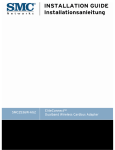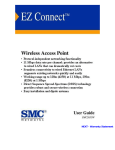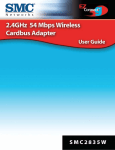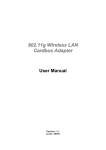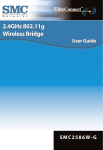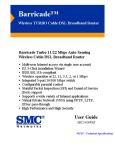Download SMC EliteConnect PCI Card
Transcript
Copyright Information furnished by SMC Networks, Inc. (SMC) is believed to be accurate and reliable. However, no responsibility is assumed by SMC for its use, nor for any infringements of patents or other rights of third parties which may result from its use. No license is granted by implication or otherwise under any patent or patent rights of SMC. SMC reserves the right to change specifications at any time without notice. Copyright © 2003 by SMC Networks, Inc. 38 Tesla Irvine, California 92618 All rights reserved. Trademarks SMC is a registered trademark; and EliteConnect is a trademark of SMC Networks. Other product and company names are trademarks or registered trademarks of their respective holders. 1 Federal Communication Commission Interference Statement This equipment has been tested and found to comply with the limits for a Class B digital device, pursuant to Part 15 of the FCC Rules. These limits are designed to provide reasonable protection against harmful interference in a residential installation. This equipment generates, uses and can radiated radio frequency energy and, if not installed and used in accordance with the instructions, may cause harmful interference to radio communications. However, there is no guarantee that interference will not occur in a particular installation. If this equipment does cause harmful interference to radio or television reception, which can be determined by turning the equipment off and on, the user is encouraged to try to correct the interference by one of the following measures: z Reorient or relocate the receiving antenna. z Increase the separation between the equipment and receiver. z Connect the equipment into an outlet on a circuit different from that to which the receiver is connected. z Consult the dealer or an experienced radio/TV technician for help. FCC Caution: To assure continued compliance, (example – use only shielded interface cables when connecting to computer or peripheral devices). Any changes or modifications not expressly approved by the party responsible for compliance could void the user’s authority to operate this equipment. This transmitter must not be co-located or operating in conjunction with any other antenna or transmitter. FCC Radiation Exposure Statement This equipment complies with FCC radiation exposure limits set forth for an uncontrolled environment. This equipment should be installed and operated with minimum distance 20 cm between the radiator & your body. This device complies with Part 15 of the FCC Rules. Operation is subject to the following two conditions: (1) This device may not cause harmful interference, and (2) this device must accept any interference received, including interference that may cause undesired operation. Industry Canada - Class B This digital apparatus does not exceed the Class B limits for radio noise emissions from digital apparatus as set out in the interference-causing equipment standard entitled “Digital Apparatus,” ICES-003 of Industry Canada. Cet appareil numerique respecte les limites de bruits radioelectriques applicables aux appareils umeriques de Classe B prescrites dans la norme sur le material brouilleur: “Appareils Numeriques,” NMB-003 edictee par l’Industrie. EC Conformance Declaration - Class B SMC contact for these products in Europe is: SMC Networks Europe, Edificio Conata II, Calle Fructuós Gelabert 6-8, Planta 2, 08970 - Sant Joan Despí, Barcelona, Spain. This RF product complies with R&TTE Directive 99/5/EC (Annex IV) and with the requirements of the Council Directive 89/336/EEC on the Approximation of the laws of the Member States relating to Electromagnetic Compatibility and 73/23/EEC for electrical equipment used within certain voltage lim2 its and the Amendment Directive 93/68/ EEC. For the evaluation of the compliance with these Directives, the following standards were applied: • Electromagnetic compatibility and radio spectrum matters (ERM) EN300 328-1 (2001-12) and EN300 328-2 (2001-12) • Electromagnetic Compatibility (EMC) Standard for radio equipment and services EN301 489-1 and EN301 489-17 • Safety Test EN60950 • Immunity to conducted disturbances, Induced by radio-frequency fields EN 61000-4-6:1996 (0.15 80 MHz with 1 kHz AM 80% Modulation: 3 V/m) • Power frequency magnetic field immunity test according to EN 61000-4-8:1993 (1 A/m at frequency 50 Hz) • Voltage dips, short interruptions and voltage variations immunity test according to EN 61000-4-11:1994 (>95% Reduction @10ms, 30% Reduction @500 ms, >95% Reduction @5000 ms) • LVD: EN 60950 (A1/1992; A2/1993; A3/1993; A4/1995; A11/1997) • MDD: IEC 60601-1 Wichtige Sicherheitshinweise (Germany) 1. Bitte lesen Sie diese Hinweise sorgfältig durch. 2. Heben Sie diese Anleitung für den späteren Gebrauch auf. 3. Vor jedem Reinigen ist das Gerät vom Stromnetz zu trennen. Verwenden Sie keine Flüssig- oder Aerosolreiniger. Am besten eignet sich ein angefeuchtetes Tuch zur Reinigung. 4. Die Netzanschlußsteckdose soll nahe dem Gerät angebracht und leicht zugänglich sein. 5. Das Gerät ist vor Feuchtigkeit zu schützen. 6. Bei der Aufstellung des Gerätes ist auf sicheren Stand zu achten. Ein Kippen oder Fallen könnte Beschädigungen hervorrufen. 7. Die Belüftungsöffnungen dienen der Luftzirkulation, die das Gerät vor Überhitzung schützt. Sorgen Sie dafür, daß diese Öffnungen nicht abgedeckt werden. 8. Beachten Sie beim Anschluß an das Stromnetz die Anschlußwerte. 9. Verlegen Sie die Netzanschlußleitung so, daß niemand darüber fallen kann. Es sollte auch nichts auf der Leitung abgestellt werden. 10. Alle Hinweise und Warnungen, die sich am Gerät befinden, sind zu beachten. 11.Wird das Gerät über einen längeren Zeitraum nicht benutzt, sollten Sie es vom Stromnetz trennen. Somit wird im Falle einer Überspannung eine Beschädigung vermieden. 12. Durch die Lüftungsöffnungen dürfen niemals Gegenstände oder Flüssigkeiten in das Gerät gelangen. Dies könnte einen Brand bzw. elektrischen Schlag auslösen. 13. Öffnen Sie niemals das Gerät. Das Gerät darf aus Gründen der elektrischen Sicherheit nur von authorisiertem Servicepersonal geöffnet werden. 14. Wenn folgende Situationen auftreten ist das Gerät vom Stromnetz zu trennen und von einer qualifizierten Servicestelle zu überprüfen: a. Netzkabel oder Netzstecker sind beschädigt. b. Flüssigkeit ist in das Gerät eingedrungen. c. Das Gerät war Feuchtigkeit ausgesetzt. d. Wenn das Gerät nicht der Bedienungsanleitung entsprechend funktioniert oder Sie mit Hilfe dieser Anleitung keine Verbesserung erzielen. e. Das Gerät ist gefallen und/oder das Gehäuse ist beschädigt. f. Wenn das Gerät deutliche Anzeichen eines Defektes aufweist. 15. Stellen Sie sicher, daß die Stromversorgung dieses Gerätes nach der EN60950 geprüft ist. Ausgangswerte der Stromversorgung sollten die Werte von AC 7,5-8V, 50-60Hz nicht über- oder unterschreiten sowie den minimalen Strom von 1A nicht unterschreiten. Der arbeitsplatzbezogene Schalldruckpegel nach DIN 45 635 Teil 1000 beträgt 70dB(A) oder weniger. 3 1| Overview The new SMC2512W-AG offers some of the highest dual band transmitting power and receive sensitivity in the industry. The SMC EliteConnect Universal 2.4GHz/5GHz High Power Wireless PCI Card provides an extended operating range compared to the standard 802.11a/802.11b/802.11g clients. Since it has the ability to significantly decrease indoor multi-path distortion, users will experience dramatic improvements in the quality and throughput of their wireless networking. Equipped with the flexibility of 802.11a, 802.11b, and 802.11g, the SMC2512W-AG fits in and works throughout any wireless enterprise network. Based on the IEEE 802.11a/b/g standards, the new product can be configured for Ad-hoc mode (Peer-to-Peer) or Infrastructure mode (communication to the wired network via an Access Point). Since it is based on the 802.11a/b/g/ standard, it is interoperable among different 802.11a/b/g compliant vendors. The included EZ Installation Wizard enables quick and easy setup, saving time and resources when setting up the wireless users. The new SMC2512W-AG Universal High Power Wireless PCI Card consists of two components: SMC2512W-AG PCI Card and SMC2536W-AG Wireless Cardbus Adapter. The SMC2512W-AG PCI Card is a high-performance PCI Card that bridges between PCI and PC Card desktop computer interfaces. It is compliant with both 16-bit and 32-bit PC Card specification defined in PCMCIA Release 2.1 and JEIDA 4.1 notes, plus it is able to support any combination of 8-bit, 16-bit, or 32-bit PC Cards in one socket that has 3.3V or 5.0V power requirements. The SMC2536W-AG is an 802.11a/b/g High Power Wireless Cardbus Adapter that connects with an existing Ethernet installation so wireless users can gain instant network access and resources. This combined solution becomes EliteConnect Universal 802.11a/b/g High Power Wireless PCI Card which enables superior performance, range and reliability for wireless desktop users. 4 2| Features • PCI Local Bus Specification Revision 2.2 compliant • 95/97 PC Card Standard compliant • • • • 3.3V or 5V operation IEEE 802.11a, 802.11b and 802.11g compliant 2.4GHz/5GHz unlicensed frequency band Data rates up to 108 Mbps turbo mode in 802.11a, up to 54 Mbps in 802.11g, and up to 11 Mbps in 802.11b with auto-fallback feature High transmit power up to 100mW in 802.11a, 100mW in 802.11g, and 125mW in 802.11b Extended operating range up to 2,145 feet Enterprise level of security includes support of 64-bit, 128-bit or 152-bit WEP encryption in 802.11a mode; 64-bit or 128-bit WEP encryption in 802.11b and 802.11g modes, Wi-Fi Protected Access (WPA), 802.1x, EAP-MD5, EAP-TLS, EAP-TTLS, EAP-PEAP and LEAP for user authentication, and Advanced Encryption Standard (AES) in all 802.11a/b/g EZ Installation Wizard Ad-hoc or Infrastructure mode Automatic channel selection Site survey utility Ability to define multiple Profile settings Supports Major Windows Operating Systems • • • • • • • • 5 3| System Requirements • • • • • • • IBM PC compatible computer An available PCI expansion slot CDROM drive Windows 98SE/ME/2000/XP Minimum of 32MB RAM and 300 MHz CPU Minimum of 1 MB available hard disk space for utility and driver installation Another IEEE 802.11a/b/g compliant device installed in your network, such as the SMC2555W-AG EliteConnect Universal 2.4GHz/5GHz Wireless Access Point, or another PC with a wireless adapter, such as the SMC2336W-AG EZ-Stream Universal 2.4GHz/5GHz Wireless Cardbus Adapter 6 4| Package Contents After unpacking the EliteConnect Universal 2.4GHz/5GHz High Power Wireless PCI Card, check the contents of the box to be sure you have received the following components: • 1 SMC2512W-AG EliteConnect PCI Card • 1 SMC2536W-AG EliteConnect Universal High Power Wireless Cardbus Adapter • 1 EZ Installation Wizard and Documentation CD • 1 Quick Installation Guide Immediately inform your dealer in the event of any incorrect, missing or damaged parts. If possible, please retain the carton and original packing materials in case there is a need to return the product. Please register this product and upgrade the product warranty at SMC's web site: http://www.smc.com 7 5| Getting Started Warning: This network adapter requires a PC and BIOS that supports the PCI Local Bus Specification v2.2 or later. If you are installing in an older computer model, upgrade the BIOS to the latest version. In addition, network cards are sensitive to static electricity. To protect the card, avoid touching its electrical components and always touch the metal chassis of your computer before handling the card. 1. Switch off the computer, unplug the power cord, and remove the computer’s cover. 2. Select an available PCI slot and remove the cover bracket. 3. Install the SMC2512W-AG PCI Card into the slot so that it is firmly seated. Screw the card’s bracket securely into the computer’s chassis. Note: Be careful that it does not touch any conducting parts on the computer motherboard. 4. Attach the SMC2536W-AG Wireless Cardbus Adapter to the PC card socket of the SMC2512W-AG PCI Card. 5. Replace the chassis cover on your computer and power it on. 6. The Wireless PCI Card should be automatically configured by the host computer’s BIOS. However, if you have an older computer, you may have to manually configure the computer’s BIOS settings. 8 6| Driver Installation – Option 1 (EZ Installation Wizard – Recommended) Windows 98SE/ME/2000/XP NOTE: Installation processes will require the use of your original, licensed copy of Windows. Please have your Windows CD available BEFORE proceeding with the installation. This installation method makes the process as simple and Plug-and-Play as possible. Simply run the EZ Installation Wizard, reboot your machine and insert your EliteConnect Universal 2.4GHz/5GHz High Power Wireless PCI Card. It's as easy as 1-2-3. Step 1: Insert the EZ Installation Wizard and Documentation CD. Step 2: Click the [Install Driver/Utility] button. For Windows 2000/XP skip to Step 7. For Windows 98SE/ME, go to Step 3. Setup Program. Follow the installation instructions for the Winroute Step 3: Click the [Next>] button. 9 Step 4: Read the License Agreement and click [Yes] to accept the terms and continue. Step 5: Select the destination folder (default folder recommended) and click [Next>] button to continue. Step 6: After installation has completed, click on “No, I will restart my computer later”. Then continue to install the SMC2536W-AG driver and utility. Step 7: Install the SMC2536W-AG Driver & Utility. Click the [Next>] button to begin installation. 10 Step 8: Choose the installation folder (default folder recommended), and click [Next>] to continue. Step 9: Click [Next>] to continue. 11 Step 10: Click [Next>] to begin copying files. Step 11: Setup has finished the installation. Click [Finish] to exit the wizard. Section 6.1| Other Setup Processes The following are Operating System-specific options that may appear during this installation procedure: Windows 98SE/ME: If you are using Windows 98SE, you must have your original Windows CD on hand. In Windows ME, the installation process is fully Plug-and-Play. Windows 2000/XP: Select [Install the software automatically] if prompted and click [Next] to complete the installation. Continue to the Utility Configuration section for documentation on how to use the utility application for your SMC2536W-AG Wireless Cardbus Adapter. 12 7| Driver Installation – Option 2 (Manually) Windows 98SE/ME/2000/XP Section 7.1| Installing SMC2512W-AG PCI Card - Software Setup The device driver software contained in the Setup program is necessary for appropriate operation of the SMC2512W-AG PCI Card. Together with the special IRQ steering circuit embedded in the chipset, the driver software accomplishes necessary hardware configuration and IRQ routing emulation for the SMC2512W-AG PCI Card. Included in the Setup program are software drivers for various operating systems, including Windows 98SE/ME/2000. NOTE: SMC2512W-AG PCI Card in Windows 2000 and Windows XP requires no software setup. For all the other supported system, software setup should be performed first, then install the WLAN PC card driver. A setup program is provided to automatically identify the running system and install corresponding software driver accordingly. Please refer to following instructions to install the device driver software for your SMC2512W-AG PCI Card. * If your system is Windows 2000 or Windows XP, you can skip this chapter. 1. Power on your computer with Windows 98SE/ME/2000. 2. Insert the EZ Installation Wizard and Documentation CD into your CDROM drive. 3. Click on the Start button on the task bar to open the start menu. 4. Click on Run, the Run dialog box appears. 5. In the text box, type in d:\Winroute\Setup.exe (where d: is the CDROM driver letter) to execute the setup program. 6. The welcome dialog box appears, click Next> to continue setup. 7. The Software License Agreement dialog box appears. Read through the software license agreement, and then click Yes to continue setup procedure. 13 8. The setup program will automatically identify the running system, install corresponding software, and configure your system for the SMC2512W-AG PCI Card. Following the completion of software driver setup, the Setup complete dialog box appears. 9. Click Finish to complete the software setup. Section 7.2 | Installing SMC2512W-AG PCI Card - Hardware Setup CAUTION: Do not install the SMC2512W-AG PCI Card until the software setup is completed. After software setup, please refer to the following instructions to install your SMC2512W-AG PCI Card. 1. Before installing your SMC2512W-AG PCI Card, please power off your computer and remove the power plug from the wall outlet. 2. Disassemble and remove the cover of your computer. For instructions on removing the cover of your computer, please refer to the manual provided with your computer. 3. Locate a free PCI slot, install the PCI adapter into the slot and utilize the mounting screw to secure the PCI adapter in place. 4. Replace and secure the cover of your computer. 5. Re-connect the power plug back to the wall outlet and power on your computer. Hardware setup is now completed. 14 Section 7.3 | Installing SMC2536W-AG Wireless Cardbus Adapter Windows 98SE NOTE: Installation processes will require the use of your original, licensed copy of Windows. Please have your Windows CD available BEFORE proceeding with the installation. Step 1: After you have inserted the EliteConnect Universal SMC2536W-AG High Power Wireless Cardbus Adapter into the PC card socket of the SMC2512W-AG PCI Card, which has already installed in your machine, the Operating System will automatically recognize the adapter and prompt you for the appropriate drivers. Click the [Next >] button to begin the installation. Step 2: Insert the Driver CD and select the [Search for the best driver for your device] option and click [Next >]. Step 3: Clear all checkboxes except for [Specify a location:]. Then press the [Browse] button and look for the drivers on your CD-ROM. Browse to ?:\ndis5x. (Note: The "?" equals the letter of your CD-ROM drive. In most cases, this is D.) Step 4: The system should find the drivers. Click the [Next >] button to continue the installation. The wizard will show "SMC2536W-AG Universal High Power Wireless Adapter". (Note: If the system could not find the drivers, click the [< Back] button, and select the [Display a list of all the drivers...] option. Select [Network Adapters] from the list of devices, press [Have Disk] and once again browse to the location of the drivers) 15 Step 5: Once the system has copied the SMC drivers from the CD, it may then request files from your original Windows disk. Please insert the Windows CD at this time. Step 6: The system will copy the files. Do NOT press [Cancel]. Step 7: Once all the necessary files are copied from the Windows CD, the driver install process will be complete. Click [Finish] to exit the wizard. Step 8: You will then be prompted to reboot the machine. Press [Yes]. Upon reboot, the SMC2536W-AG will be initialized and ready for use. 16 Windows Me NOTE: Installation processes will require the use of your original, licensed copy of Windows. Please have your Windows CD available BEFORE proceeding with the installation. Step 1: After you have inserted the EliteConnect Universal SMC2536W-AG High Power Wireless Cardbus Adapter into the PC card socket of the SMC2512W-AG PCI Card, which has already installed in your machine and turned it back on, the OS will automatically recognize the adapter and prompt you for the appropriate drivers. Select the [Specify the location of the driver] option. Then click the [Next >] button to begin the installation. Step 2: Insert the Driver CD and select the [Specify a location:] option. Clear the [Removable Media] checkbox. Then press the [Browse] button and look for the drivers on your CD. This should be located in ?:\ndis5x. (Note: The ? equals the letter of your CD-ROM drive. In most cases, this is D.) Then click [Next >]. Step 3: The system should find the drivers. Click the [Next >] button to continue the installation. (Note: If the system could not find the drivers, click the [< Back] button, and select the [Display a list of all the drivers] option. Select [Network Adapters] from the list of devices, press [Have Disk] and once again browse to the location of the drivers) Step 4: Once all the necessary files have been copied, the driver installation is complete. Click [Finish] to exit the wizard. 17 Step 5: You will then be prompted to reboot the machine. Press [Yes]. Upon reboot, the SMC2536W-AG will be initialized and ready for use. Windows 2000 Step 1: After you have inserted the EliteConnect Universal SMC2536W-AG High Power Wireless Cardbus Adapter into the PC card socket of the SMC2512W-AG PCI Card, which has already installed in your machine and turned it back on, the Operating System will automatically recognize the adapter and prompt you for the appropriate drivers. Click the [Next >] button to begin the installation. Step 2: Insert the Driver CD and select the [Search for a suitable driver...] option. Then click [Next >]. Step 3: Clear all checkboxes except for [Specify a location]. Then click [Next >]. 18 Step 4: You will then be prompted to enter the location of the drivers. This should be ?:\ndis5x. (Note: The ? equals the letter of your CD-ROM drive. In most cases, this is D.) Then click [OK]. You can also click [Browse] and browse to the location of the drivers on the CD for further verification. Step 5: The system should find the drivers. Click the [Next >] button to continue the installation. (Note: If the system could not find the drivers, click the [< Back] button, and select the [Display a list of the known drivers...] option. Select [Network Adapters] from the list of devices, press [Have Disk] and once again browse to the location of the drivers. Step 6: You have now completed the driver installation. Click [Finish] to initialize the adapter. Windows XP Step 1: After you have inserted the EliteConnect Universal SMC2536W-AG High Power Wireless Cardbus Adapter into the PC card socket of the SMC2512W-AG PCI Card, which has already installed in your machine and turned it back on, the Operating System will automatically recognize the adapter and prompt you for the appropriate drivers. Select [Install from a list or specific location] and click the [Next >] button to begin the installation. 19 Step 2: Insert the Driver CD and check the [Include this location in the search] option. Make sure the [Search removable media] option is not checked. Click [Browse] and find the location of the drivers. This should be ?:\ndis5x. (Note: The ? equals the letter of your CD-ROM drive. In most cases, this is D.) Then click [Next >]. Step 3: This process will be completed once the drivers are copied to the hard drive and installed. Please click [Finish] to exit the wizard. After clicking [Finish], you will see the following message in your system tray: 20 8 | Utility Installation Windows 98SE/ME/2000/XP This Installation method makes the process as simple and Plug-and-Play as possible. Simply run the EZ Installation Wizard, reboot your machine and insert your EliteConnect Universal SMC2536W-AG High Power Wireless Cardbus Adapter into the PC Card socket of the SMC2512W-AG PCI Card. It's as easy as 1-2-3. Step 1: Insert the EZ Installation Wizard and Documentation CD. Step 2: Click the [Install Driver/Utility] button (Note: If you completed the DRIVER INSTALLATION OPTION #1, you do NOT need to install the utility. Please skip to "Utility Configuration"). Step 3: The installation wizard will begin. Click [Next >]. 21 Step 4: You will be given the option to choose the location where the Configuration Utility will be installed. It is recommended to leave this at the default value. Click [Next >] to continue. You will also be given the option to choose the Folder name that will appear in the Start Menu. It is recommended to leave this at the default value. Click [Next >] to continue. Step 5: Click [Next] to begin copying the utility files to your computer. 22 You have now completed the utility installation process. Click [Finish] to exit the wizard. Step 6: Please shut down your machine. Then insert your SMC2536W-AG into the PC Card socket of the SMC2512W-AG PCI Card and boot up the operating system. Utility Configuration When the utility program is running, there will be a quick launch icon in the lower right-hand corner of the taskbar. The icon will be GREEN if you have a good connection to a wireless network. If it is red, you will need to verify the network settings and check to be sure that the Wireless Access Point on your network is turned on. You may also need to re-position the Access Point and place it in a higher position so that you are able to gain more wireless signal strength. Double-click the quick launch icon in the system tray to bring up the Configuration Utility. This provides quick access to management statistics and adapter settings. The Configuration Utility includes the following tabs: Profile Management: Allows you to implement Profile Management, edit SSID data, change the Tx Rate and Operating mode, and enable 64/128/152-bit WEP or advanced security such as LEAP, PEAP, TLS, or TTLS. 23 Link Information: Allows you to view/monitor network status, throughput and wireless channel information. IP Information: Displays TCP/IP data. Site Survey: Displays all the Access Points within range of the wireless adapter's signal. Allows you to select your desired WLAN. Driver Information: Shows the driver and utility version information. Section 8.1 | Configuration The profile management window will show you the current selected profile of the wireless card. Click [New] to create a new profile. Click [Modify] to modify the current settings in the selected profile. Click [Remove] to delete the current profile. Click [Activate] to initialize a different profile. 24 When you want to create a new network, you must enter the Profile Name. Also enter the SSID of your network in any of the fields show under "Network Names". If you have more than one Access Point in your local network with identical security settings, you can enter up to three different SSID values - representing up to three different WLANs in your vicinity. Then go to “Security” tab of the SMC2536W-AG Utility to configure various encryption options. To configure WPA (Wi-Fi Protected Access), choose “WPA” under “Set Security Method”. lecting WPA, you will be given the option of using WAP EAP Type: TLS or PEAP. Select TLS and then [Configure] to configure TLS options. 25 After se- You must have a digital certificate installed on your machine. If you do not, you will see the following error message: To configure PEAP, make sure WPA is selected. Then select PEAP and then [Configure]. Enter the User name and Password. After that click the [Advanced Configuration] button, you can then specify the Server or Domain and Login Name information. 26 For configuring 802.1x security method, select 802.1x under “Set Security Method”, you will be given the option of using 802.1x EAP Type: TLS, PEAP, or LEAP. Click TLS and then [Configure] to configure TLS options. You must have a digital certificate installed on your machine. If you do not, you will see the following error message: Click PEAP and then [Configure] to configure PEAP options. 27 Enter the User name and Password. After that click the [Advanced Configuration] button, you can then specify the Server or Domain and Login Name information. Click LEAP and then [Configure] to configure LEAP options. 28 NOTE: PLEASE CONSULT YOUR NETWORK ADMINISTRATOR FOR ASSISTANCE IN CONFIGURING THESE ADVANCED SECURITY OPTIONS. In addition to WPA and 802.1x, there are the options to enable WEP (Pre-Shared Key) or the new Wi-Fi Protected Access Pre-Shared Key (WPA-PSK) on your wireless LAN. For WEP (Wired Equivalent Privacy) security, the SMC2536W-AG Utility supports HEX and ASCII key entries. For the HEX Key Format, the security is enabled by entering 10-digit keys for the 64-bit WEP configuration, 26-digit keys for a 128-bit WEP configuration, and 32-digit keys for a 152-bit WEP configuration. Allowed hex keys are 0-9 and A-F. For the ASCII Key Format, the security is enabled by entering 5 characters for 64-bit WEP, 13 characters for 128-bit WEP and 16 characters for 152-bit WEP. Click Pre-Shared Key and select the [Configure] button to enter in WEP keys. Select the desired encryption strength from the drop-down menu on the right (64-, 128- or 152-bit) and then enter the appropriate keys in Key 1, 2, 3, or 4. Remember to select the correct radio button on the left. Then click [OK]. 29 For WPA-PSK Security, select WPA-PSK under “Set Security Method”, and then click [Configure] to enter your WPA key. After selecting the Configure option, you will be able to set your WPA Pre-Shared Key (WPA-PSK). WPA-PSK supports both Passphrase (8-63 Characters) and Hexadecimal (64 Characters) keys. NOTE: WPA is currently available under Windows 2000 and Windows XP. Support for Windows 98SE/ME will be available in Q1 of 2004. 30 Under the Profile Management Window, click on [Advanced] tab for advanced configurations. Power Save Mode: Normal, Maximum, Off (Default Off) Network Type: Access Point (Infrastructure) or Ad hoc (Peer to Peer) 802.11b Preamble: Short & Long or Long Only Transmit Power Level: Choose between 100%, 50%, 25%, 12.5%, Lowest. Wireless Mode: Configure which 802.11 standard is used for each profile 802.11a 5GHz, 802.11b/g 2.4GHz. Section 8.2 | Link Information 31 Associated BSS ID: Shows the MAC Address of the associated Access Point Channel: Shows the current operating channel of your WLAN Current Tx Rate: Current transmit rate value Throughput: Number of packets sent and received SSID: Workgroup name of the wireless network that you are connected to Encryption: Displays the current Encryption used on the Network. Link Quality: Shows the relative link quality (e.g., lack of frame errors) of the wireless connection to the Access Point. Section 8.3 | IP Information The IP Information screen displays network connection information. Includes [Release] and [Renew] buttons to release and renew the IP address. Section 8.4 | Site Survey The Site Survey tab scans and displays all Access Points on the wireless LAN. The data is organized by columns signifying the "SSID", "Channel", "Encryption" (a KEY symbol), "Signal", and "Wireless Mode". If there is a key symbol in the Encryption column, the network is encrypted. You will need to obtain the WEP information from the network administrator. To choose a network, simply click the "SSID" and click the [Activate] button. 32 Section 8.5 | Driver Information The Driver Information screen displays the version information. 33 9 | Disable Wireless Zero Configuration in Windows XP It is recommended that you use the SMC2536W-AG Configuration Utility to manage your wireless connection. If you are using the SMC utility in Windows XP, you will need to disable the Wireless Zero Configuration. Follow the instructions below. Go to [Control Panel] and open [Network Connections]. Right-click the [Wireless Network Connection], and select [Properties]. Select the "Wireless Networks" tab and uncheck the [Use Windows to configure my wireless network settings] check box. NOTE: The Wireless Zero Configuration (WZC) and SMC2536W-AG Universal WLAN Utility cannot be used simultaneously. If you are using the SMC2536W-AG Universal WLAN Utility, you MUST disable the WZC (and vice versa). 34 10 | SMC Networks EliteConnect Universal SMC2536W-AG Wireless Cardbus Adapter Maximum Distance Table Important Notice Maximum distances posted below are actual tested distance thresholds. However, there are many variables such as barrier composition and construction, as well as local environmental interference that may impact your actual distances and cause you to experience distance thresholds far lower than those posted below. If you have any questions or comments regarding the features or performance of this product, or if you would like information regarding our full line of wireless products, you can visit us at www.smc.com, or you can call us toll-free at 800.SMC.4YOU. SMC Networks stands behind every product sold with a 30-day satisfaction guarantee and a limited-lifetime warranty. 802.11a Wireless Distance Table Speed (Mbps) and Distance Ranges Environmental Condition Outdoors: A line-of-sight environment with no interference or obstruction between the Access Point and users. Indoors: A typical office or home environment with floor to ceiling obstructions between the Access Point and users. 108 72 45 m 75 m (147 ft) (246 ft) 15 m (49 ft) 40 m (131 ft) 54 48 36 24 18 12 9 6 305 m 385 m 435 m 485 m 500 m 500 m 650 m (492 ft) (1000 ft) (1263 ft) (1427 ft) (1591 ft) (1640 ft) (1804 ft) (2145 ft) 45 m 55 m 60 m 62 m 65 m 70 m 80 m 95 m (148 ft) (180 ft) (197 ft) (203 ft) (213 ft) (230 ft) (262 ft) (312 ft) 150 m 35 802.11g Wireless Distance Table Speed (Mbps) and Distance Ranges Environmental Condition Outdoors: A line-of-sight environment with no interference or obstruction between the Access Point and users. Indoors: A typical office or home environment with floor to ceiling obstructions between the Access Point and users. 54 48 36 24 18 150 m 205 m 350 m 395 m 450 m (269 ft) (328 ft) (984 ft) (1082 ft) (1148 ft) 35 m 50 m 65 m 85 m 110 m (115 ft) (164 ft) (213 ft) (361 ft) 11 9 6 5 2 1 505 m 515 m 530 m 535 m 560 m 565 m (1541 ft) (1590 ft) (1623 ft) (1672 ft) (1705 ft) (1853 ft) 120 m 120 m 125 m 130 m 135 m 140 m 145 m (394 ft) (394 ft) (410 ft) (426 ft) (443 ft) (459 ft) (476 ft) 500 m (1475 ft) 802.11b Wireless Distance Table Speed and Distance Ranges Environmental Condition Outdoors: A line-of-sight environment with no interference or obstruction between the Access Point and users. Indoors: A typical office or home environment with floor to ceiling obstructions between the Access Point and users. (279 ft) 12 11 Mbps 5.5 Mbps 2 Mbps 1 Mbps 365 m 495 m 520 m 535 m (1197 ft) (1624 ft) (1706 ft) (1755 ft) 85 m 95 m 115 m 125 m (279 ft) (312 ft) (377 ft) (410 ft) 36 11 | Troubleshooting Common Installation Problems Problems are often caused by conflicts with other devices installed in the same computer, or software that has been configured incorrectly. If you encounter a problem with the EliteConnect Universal SMC2512W-AG 2.4GHz/5GHz High Power PCI Card, use the following checklists to identify and correct the problem. • If your computer cannot find the Wireless Card, or the network driver does not install correctly, check the following items before contacting SMC Technical Support o Make sure the cards are securely seated in the PCI slot and PC Card socket slot. Check for any hardware problems, such as physical damage to the cards. o Try the card in another PCI slot. If this fails, test the card in a completely different system or try using a second Wireless Card in that particular slot. o Check for resource conflicts o Make sure your computer is using the latest BIOS available. Contact the manufacturer of the laptop, motherboard for information on updating the BIOS (e.g. – Dell, Toshiba, etc) o If there are other network cards in the computer, they may be causing conflicts. Remove all other cards from the computer and test the Wireless Card separately. Network Connection Problems There may be a network connection problem if the LED on the card does not light, or if you cannot access any network resources from the computer. Check the following items before contacting SMC Technical Support. • • • • • Make sure the correct network card driver is installed for your operating system. If necessary, try uninstalling and reinstalling the driver. To do this, first shut down your machine and remove your SMC adapter. Then boot up and open up your Start Menu, go to Programs, click the "SMC2536W-AG WLAN Utility" program folder and choose "Uninstall". Reboot the machine when requested to do so. Then insert your Driver CD and run the Setup.exe utility again. Then shut down the computer, reinsert your SMC adapter and boot up the machine. The OS should properly reinstall the adapter during this time. Make sure the computer and other network devices are receiving power. If you suspect a power outlet to be faulty, plug another device into it to verify that it is working. If your wireless station cannot communicate with a computer on the Ethernet LAN when configured for Infrastructure mode, try changing the wireless channel on the AP. Make sure the SSID is the same as that used by the AP for a station with roaming disabled, or the same as that used by the AP's in the extended service set (ESS). The Access Point you are trying to attach to is defective or may not be configured properly to accept your signal. Check with the administrator of your wireless network for more information on connecting to the LAN. Also run the necessary diagnostics on the AP to make sure the unit is fully operational. If you cannot access the Internet, be sure to check with the ISP for further instructions once the drivers for the Wireless Card are installed properly. Compaq DeskPro EN issue If your computer is COMPAQ DeskPro EN series, you may encounter the following problems: System freezes while booting up after installing SMC2512W-AG PCI Card in the computer. Solution: Before installing the PCI Card, please go to Http://www.compaq.com/ to download the latest version of ROMPaq ROM Image (V2.11 or later); the follow the instructions COMPAQ provides to update the system BIOS. You can install the software and hardware of SMC2512W-AG PCI Card without problems after the BIOS is updated. 37 As setup program is provided to automatically identify the running system and install corresponding software driver accordingly. Please refer to above instructions to install the device driver software for your SMC2512W-AG PCI Card. PCI card installation If you have problem with inserting SMC2512W-AG PCI Card into the PCI socket of your computer, please DO NOT push and enforce the card into the socket. This may cause unexpected damage to your WLAN card or SMC2512W-AG PCI Card. At this condition, turn the card over and try it again. 38 12 | Specifications SMC2512W-AG PCI Card Standards • PCI Local Bus Specification 2.2 • PC Card 95/97 PC-16 Standard Specification • ACPI (PCI Power Management 1.0) Interface • PCI interface card Dimension • 6.875” (L) X 4.75” (W) [including PC Card] Weight • 0.28 lbs [including PC Card] Ambient Temperature • 0oC~70oC Storage Temperature • -40oC~125oC Operating Systems • Windows 98SE/ME/2000/XP Power Supply Current (Operating) • 50mA SMC2536W-AG Standards: • 802.11a • 802.11b • 802.11g Host Interface: • Cardbus form factor with 32-bit interface, PC Card Standard v7.1 Type II Operation Mode: • Infrastructure & Ad-hoc mode Transfer Data Rate: 802.11a (Normal mode) • 54, 48, 36, 24, 18, 12, 9, 6Mbps, auto-fallback 802.11a (Turbo mode) • 108,96,72,48,36,24,18,12 Mbps, auto-fallback 802.11b/g • 11, 5.5, 2, 1 Mbps, auto-fallback, up to 54 Mbps 39 Operating Range: • 802.11a - up to 2,145 feet • 802.11b – up to 1,766 feet • 802.11g – up to 1,865 feet Security: • 64-bit, 128-bit, 152-bit WEP Encryption • Wi-Fi Protected Access (WPA) • 802.1x, EAP-MD5, EAP-TLS, EAP-TTLS, LEAP, PEAP Authentication • AES & TKIP Encryption Frequency Range: North America: • 2.412 ~ 2.462GHz, 5.15 ~ 5.35GHz, 5.725 ~ 5.825GHz • 2.400 – 2.483GHz Europe: • 2.412 ~2.472GHz, 5.15~ 5.35GHz, 5.47 ~ 5.725GHz • 2.400 – 2.483GHz Japan: • 2.421 ~ 2.484Ghz, 5.15 ~ 5.25GHz • 2.400 – 2.483GHz, 4.90 – 5.091GHz, 5.15 – 5.25GHz China: • 2.412 ~ 2.484GHz, 5.725 ~5.85GHz • 2.400 – 2.483GHz Modulation Technique: 802.11b/g • DSSS (DBPSK, DQPSK, CCK) • OFDM for data rate > 20 Mbps 802.11a • OFDM (BPSK, QPSK, 16-QAM, 64-QAM) Channels: 802.11b/g • • • • • US/Canada: 11 (1 ~ 11) Major European countries: 13 (1 ~ 13) France: 4 (10 ~ 13) Japan: 14 (1~13 or 14 th ) China: 13 (1 ~ 13) 802.11a US/Canada: • 12 non-overlapping channels (5.15 ~ 5.35GHz, 5.725 ~ 5.825GHz) Europe: • 19 non-overlapping channel (5.15 ~ 5.35GHz, 5.47 ~ 5.725GHz) Japan: • 4 non-overlapping channels (5.15 ~ 5.25GHz) 40 Media Access Protocol: • CSMA/CA Antenna: • Integrated Patch Antenna Output Power: • 11a mode: • • 20 dBm +-2dBm at 6~24Mbps 19-dBm +-2dBm at 36 Mbps 17-dBm +-2dBm at 48 Mbps 15-dBm +-2dBm at 54 Mbps 11g mode: 20 dBm+-2dBm at 6~24Mbps 19-dBm +-2dBm at 36 Mbps 17-dBm +-2dBm at 48 Mbps 15-dBm +-2dBm at 54 Mbps 11b mode: 21-dBm +-2dBm at 11Mbps Operational Voltage: • 3.3/5V Current Consumption: TX: 11a: < 700 mA 11b/g: < 850 mA RX: 11a: < 300 mA 11b/g: < 500 mA Receive sensitivity: 802.11a: < -80 dBm at 6 Mbps < -80 dBm at 9 Mbps < -79 dBm at 12 Mbps < -78 dBm at 18 Mbps < -75 dBm at 24 Mbps < -73 dBm at 36 Mbps < -70 dBm at 48 Mbps < -67 dBm at 54 Mbps 802.11g: < -84 dBm at 6 Mbps < -84 dBm at 9 Mbps < -83 dBm at 12 Mbps < -82 dBm at 18 Mbps < -79 dBm at 24 Mbps < -77 dBm at 36 Mbps < -74 dBm at 48 Mbps < -71 dBm at 54 Mbps 802.111b: < -91 dBm at 1 Mbps < -89 dBm at 2 Mbps < -88 dBm at 5.5 Mbps < -87 dBm at 11 Mbps LED: • Link/Activity 41 Operation Systems: • Windows 98SE, ME, 2K, XP Compliance: • Wi-Fi Compliant • FCC part 15 (USA) • IC RSS210 (Canada) • ETSI, EN301 893, EN60950 (Europe) Temperature Range: • 10°C to 60°C – Operating • -40°C to 70°C – Storage Humidity (non-condensing): 5% ~ 95% typical 42 13 | Frequently Asked Questions What is a Wireless LAN? A local area network that transmits over the air typically in an unlicensed frequency such as the 2.4GHz band. A wireless LAN does not require lining up devices for line of sight transmission like IrDA. Wireless access points (base stations) are connected to an Ethernet hub or server and transmit a radio frequency over an area of several hundred to a thousand feet which can penetrate walls and other non-metal barriers. Roaming users can be handed off from one access point to another like a cellular phone system. Laptops use wireless network cards that plug into an existing PCMCIA slot or that are self contained on PC cards, while stand-alone desktops and servers use plug-in cards (ISA, PCI, etc.). What is AD-HOC? An AD-HOC network is a peer to peer network where all the nodes are wireless clients. As an example, two PC’s with wireless adapters can communicate with each other as long as they are within range. A wireless extension point can extend the range of an AD-HOC network. What is the 802.11 standard? A family of IEEE standards for wireless LANs first introduced in 1997. 802.11 provides 1 or 2 Mbps transmission in the 2.4GHz band using either a frequency hopping modulation (FHSS) technique or direct sequence spread spectrum (DSSS), which is also known as CDMA. The 802.11b standard defines an 11 Mbps data rate in the 2.4GHz band, 802.11g-draft standard defines 54 Mbps in the 2.4GHz band, and the 802.11a standard defines 54 Mbps in the 5GHz band. What is Infrastructure? In order for your wireless components to interact with traditional wired networks they need a media bridge to translate for them. This is where INFRASTRUCTURE or Network mode comes into play. An ACCESS POINT is attached to the network using CAT-5 Ethernet cable attaching to a hub, switch or another PC. Wireless PC’s can then communicate to Wired Ethernet computers through this access point. The total range of the network is limited to a radius around this Access Point. To increase the range, extra Access Points may be wired into the network. These Access Points talk to each other over the hard-wired Ethernet cables however, they cannot communicate wirelessly to one another and they must be wired to the same network. Individual wireless PC’s can move between Access Points on the same network seamlessly due to a feature called ROAMING. What is Tx Rate? Tx-Rate or TRANSFER RATE is the current speed at which the network component is operating. SMC-802.11b products can operate at speeds of 1Mb, 2Mb, 5.5Mb, & 11Mbps. A wireless card set to AUTO will attempt to connect at whatever speed will give the best throughput on the network. What is RTS Threshold? (Request To Send) An RS-232 signal sent from the transmitting station to the receiving station requesting permission to transmit. RTS is a collision avoidance method used by all 802.11b wireless networking devices. In most cases you will not need to activate or administer RTS. Only if you find yourself in an Infrastructure environment where all nodes are in range of the Access Point but may be out of range of each other. It is recommended to leave this setting at its default value leaving this feature disabled. What is Authentication Algorithm? Authentication Algorithm is the means by which one station is authorized to communicate with another. In an Open System, any station can request authorization in accordance with the WECA standard. In a Shared key system, only stations that possess a secret encrypted key may participate in the network. This is a low level security key which allows the equipment with the shared key algorithm to see each other on the wireless lan. 43 What is DBI? The ability of the antenna to shape the signal and focus it in a particular direction is called Antenna Gain, and is expressed in terms of how much stronger the signal in the desired direction is, compared to the worst possible antenna, which distributes the signal evenly in all directions (an Isotropic Radiator). To express the relationship to the Isotropic reference, this is abbreviated: "dBi". The typical omni-directional "stick" antenna is rated at 6-8 dBi, indicating that that by redirecting the signal that would have gone straight up or down to the horizontal level, 4 times as much signal is available horizontally. A parabolic reflector design can easily achieve 24 dBi. What is WEP? Short for Wired Equivalent Privacy, WEP is a security protocol for wireless local area networks (WLANs) defined in the 802.11b and 802.11a standards. WEP is designed to provide the same level of security as that of a wired LAN. LANs are inherently more secure than WLANs because LANs are somewhat protected by the physicalities of their structure, having some or all part of the network inside a building that can be protected from unauthorized access. WLANs, which are over radio waves, do not have the same physical structure and therefore are more vulnerable to tampering. WEP aims to provide security by encrypting data over radio waves so that it is protected as it is transmitted from one end point to another. The Wired Equivalent Privacy (WEP) feature uses the RC4 PRNG algorithm developed by RSA Data Security, Inc. If your wireless access point supports MAC filtering, it is recommended that you use this feature in addition to WEP (MAC filtering is much more secure than encryption). 44 14 | Terminology 10BaseT - Physical Layer Specification for Twisted-Pair Ethernet using Unshielded Twisted Pair wire at 10Mbps. This is the most popular type of LAN cable used today because it is very cheap and easy to install. It uses RJ-45 connectors and has a cable length span of up to 100 meters. There are two versions, STP (Shielded Twisted Pair) which is more expensive and UTP (Unshielded Twisted Pair), the most popular cable. These cables come in 5 different categories. However, only 3 are normally used in LANs, Category 3, 4 and 5. CAT 3 TP (Twisted Pair) cable has a network data transfer rate of up to 10Mbps. CAT 4 TP cable has a network data transfer rate of up to 16Mbps. CAT 5 TP cable has a network data transfer rate of up to 100Mbps. Access Point - A device that is able to receive wireless signals and transmit them to the wired network, and vice versa - thereby creating a connection between the wireless and wired networks. Ad Hoc - An ad hoc wireless LAN is a group of computers, each with LAN adapters, connected as an independent wireless LAN. Adapter - A device used to connect end-user nodes to the network; each contains an interface to a specific type of computer or system bus, e.g. EISA, ISA, PCI, PCMCIA, CardBus, etc. Auto-Negotiation - A signaling method that allows each node to define its operational mode (e.g., 10/100 Mbps and half/full duplex) and to detect the operational mode of the adjacent node. Backbone - The core infrastructure of a network. The portion of the network that transports information from one central location to another central location where it is unloaded onto a local system. Base Station - In mobile telecommunications, a base station is the central radio transmitter/receiver that maintains communications with the mobile radiotelephone sets within its range. In cellular and personal communications applications, each cell or micro-cell has its own base station; each base station in turn is interconnected with other cells' bases. BSS - BSS stands for "Basic Service Set". It is an Access Point and all the LAN PCs that are associated with it. CSMA/CA - Carrier Sense Multiple Access with Collision Avoidance DHCP - Dynamic Host Configuration Protocol. This protocol automatically configures the TCP/IP settings of every computer on your home network. DNS - DNS stands for Domain Name System, which allows Internet host computers to have a domain name (such as www.smc.com) and one or more IP addresses (such as 192.34.45.8). A DNS server keeps a database of host computers and their respective domain names and IP addresses, so that when a domain name is requested (as in typing " www.smc.com" into your Internet browser), the user is sent to the proper IP address. The DNS server address used by the computers on your home network is the location of the DNS server your ISP has assigned. DSL - DSL stands for Digital Subscriber Line. A DSL modem uses your existing phone lines to transmit data at high speeds. Ethernet - A standard for computer networks. Ethernet networks are connected by special cables and hubs, and move data around at up to 10 million bits per second (Mbps). ESS - ESS (ESS-ID, SSID) stands for "Extended Service Set". More than one BSS is configured to become an Extended Service Set. LAN mobile users can roam between different BSSs in an ESS (ESS-ID, SSID). Fast Ethernet NIC - Network interface card that is in compliance with the IEEE 802.3u standard. This card functions at the media access control (MAC) layer, using carrier sense multiple access with collision detection (CSMA/CD). 45 Fixed IP – (see Static IP) Full-Duplex - Transmitting and receiving data simultaneously. In pure digital networks, this is achieved with two pairs of wires. In analog networks, or digital networks using carriers, it is achieved by dividing the bandwidth of the line into two frequencies, one for sending, one for receiving. Hub - Central connection device for shared media in a star topology. It may add nothing to the transmission (passive hub) or may contain electronics that regenerate signals to boost strength as well as monitor activity (active/intelligent hub). Hubs may be added to bus topologies; for example, a hub can turn an Ethernet network into a star topology to improve troubleshooting. IP Address - IP stands for Internet Protocol. An IP address consists of a series of four numbers separated by periods, that identifies an single, unique Internet computer host. Example: 192.34.45.8. ISP - Internet Service Provider. An ISP is a business that provides connectivity to the Internet for individuals and other businesses or organizations. LAN - A communications network that serves users within a confined geographical area. It is made up of servers, workstations, a network operating system and a communications link. Servers are high-speed machines that hold programs and data shared by network users. The workstations (clients) are the users' personal computers, which perform stand-alone processing and access the network servers as required. Diskless and floppy-only workstations are sometimes used, which retrieve all software and data from the server. Increasingly, "thin client" network computers (NCs) and Windows terminals are also used. A printer can be attached locally to a workstation or to a server and be shared by network users. Small LANs can allow certain workstations to function as a server, allowing users access to data on another user's machine. These peer-to-peer networks are often simpler to install and manage, but dedicated servers provide better performance and can handle higher transaction volume. Multiple servers are used in large networks. MAC Address - MAC (Media Access Control) A MAC address is the hardware address of a device connected to a network. MDI / MDI-X - Medium Dependent Interface - Also called an "uplink port," it is a port on a network hub or switch used to connect to other hubs or switches without requiring a crossover cable. The MDI port does not cross the transmit and receive lines, which is done by the regular ports (MDI-X ports) that connect to end stations. The MDI port connects to the MDI-X port on the other device. There are typically one or two ports on a device that can be toggled between MDI (not crossed) and MDI-X (crossed). Medium Dependent Interface – X (crossed) - A port on a network hub or switch that crosses the transmit lines coming in to the receive lines going out. NAT – (Network Address Translation) This process allows all of the computers on your home network to use one IP address. The NAT capability of the Barricade, allows you to access the Internet from any computer on your home network without having to purchase more IP addresses from your ISP. Network Address Translation can be used to give multiple users access to the Internet with a single user account, or to map the local address for an IP server (such as Web or FTP) to a public address. This secures your network from direct attack by hackers, and provides more flexible management by allowing you to change internal IP addresses without affecting outside access to your network. NAT must be enabled to provide multi-user access to the Internet or to use the Virtual Server function. Packet Binary Convulational Code(tm) (PBCC) - A modulation technique developed by Texas Instruments Inc. (TI) that offers data rates of up to 22Mbit/s and is fully backward compatible with existing 802.11b wireless networks. PCI - Peripheral Component Interconnect - Local bus for PCs from Intel that provides a high-speed data path between the CPU and up to 10 peripherals (video, disk, network, etc.). The PCI bus runs at 33MHz, supports 32-bit and 64-bit data paths, and bus mastering. 46 PPPoE - Point-to-Point Protocol over Ethernet. Point-to-Point Protocol is a method of secure data transmission originally created for dial-up connections. PPPoE is for Ethernet connections. Roaming - A function that allows your to move through a particular domain without losing network connectivity. Static IP - If your Service Provider has assigned a fixed IP address; enter the assigned IP address, subnet mask and the gateway address provided by your service provider. Subnet Mask - A subnet mask, which may be a part of the TCP/IP information provided by your ISP, is a set of four numbers configured like an IP address. It is used to create IP address numbers used only within a particular network (as opposed to valid IP address numbers recognized by the Internet. TCP/IP - Transmission Control Protocol/Internet Protocol. This is the standard protocol for data transmission over the Internet. TCP - Transmission Control Protocol - TCP and UDP (User Datagram Protocol) are the two transport protocols in TCP/IP. TCP ensures that a message is sent accurately and in its entirety. However, for real-time voice and video, there is really no time or reason to correct errors, and UDP is used instead. UDP - User Datagram Protocol - A protocol within the TCP/IP protocol suite that is used in place of TCP when a reliable delivery is not required. For example, UDP is used for real-time audio and video traffic where lost packets are simply ignored, because there is no time to retransmit. If UDP is used and a reliable delivery is required, packet sequence checking and error notification must be written into the applications. 47

















































